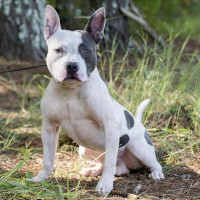Appearance of the Miniature French Bull Terrier
|
| The Miniature French Bull Terrier is a fairly small dog, generally around 30.5 centimeters in height and weighing less than 14 kilos. There are sturdy, compact dogs that are more powerful than their size suggests, with straight legs, powerful jaws and great tenacity. They have broad heads, and although they may inherit the egg-shaped skull of the Miniature Bull Terrier or the shortened muzzle of the French Bulldog, they usually fall somewhere in between, with a moderate-length muzzle and moderate stop. The eyes are dark and usually set low on the face, and can be round or triangular in shape, and this hybrid will inherit the erect ears of both parent breeds, although the French Bulldog's ears are much larger than those of the Miniature Bull Terrier. Both parent breeds have similar single-ply coats, and you can expect the offspring to also have short, glossy coats with a coarse texture. |
Temperament of the Miniature French Bull Terrier
|
| This crossbreed is generally a comical but gentle animal with people of all ages, but if they take after the Miniature Bull Terrier, they can become overexcited and cause bumps, bruises or even fall over in their enthusiasm to greet everything. Because of this trait and a possible possessiveness when it comes to their food, this breed may not be the most suitable dog for homes with young children, although they generally get on quite well with slightly older children. In many cases, these dogs will be quite agreeable with other dogs, but some individuals may show unwarranted aggression towards other dogs, particularly those of the same sex, however, effective socialization can help ward off both shyness and aggression. This hybrid can be more difficult to train than other dogs due to the French Bulldog's stubbornness and a tendency to challenge your leadership found in the Miniature Bull Terrier. |
Needs and activities of the Miniature French Bull Terrier
|
| The Miniature Bull Terrier is an energetic animal, generally requiring more exercise than other dogs of their size, however, although very young French Bulldogs can be frisky and lively, they tend to settle down and become rather calm as they mature. Around 45 minutes to an hour of vigorous activity a day is usually enough to keep them in good health, although this is more effective if broken down into several shorter exercise sessions throughout the day. This crossbreed may be more sensitive to UV damage, especially individuals with white or light coats, and canine sunscreen should be used to protect your dog from sunburn and to reduce the risk of developing skin cancers. |
Maintenance of the Miniature French Bull Terrier
|
| Grooming the Miniature French Bull Terrier should be a fairly straightforward affair, largely due to its short, easy-care coat. They don't need baths, usually every few months, and weekly brushing with a grooming glove, smooth brush or bristle brush is usually effective in removing dead hairs and restoring shine to the coat, although they can shed a lot during spring or autumn and require more frequent brushing. Dental hygiene is also particularly important for this hybrid, especially if it inherits the French Bulldog's lower jaw, and toenails are likely to require regular trimming. The ears of these dogs can also be prone to developing allergic reactions and infections, so it's essential to examine them regularly and make sure they're clean and dry. |









 English (United Kingdom)
English (United Kingdom)